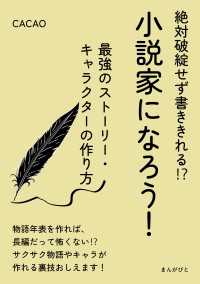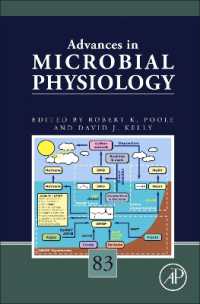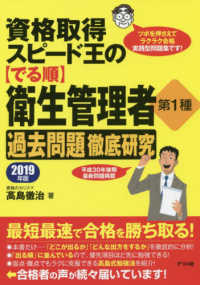- ホーム
- > 洋書
- > ドイツ書
- > Mathematics, Sciences & Technology
- > Medicine & Pharmacy
- > general survey & lexicons
Full Description
The primary aim of this textbook is to contribute towards the promotion of human security by educating nurses with a profound understanding of disaster nursing and to conduct innovative research and practices in cooperation. This textbook emphasizes on multi-professional connections; offers knowledge on how Japanese disaster nursing got evolved in changing social contexts and provides various case studies that reflect wonderful practices in the disaster nursing field which have contributed to the Sendai Framework for Disaster Risk Reduction, the UN Sustainable Development Goals, and sustainable human security.
Frequent disasters have triggered the need for more trans-disciplinary work, high-level care throughout all phases of a disaster event, and the need for nursing leaders. Apart from hospitals, in local communities, nurses can take a role to mitigate health risks. Being a member of every part of the healthcare system, they can become critically needed leaders in emergency management and disaster preparedness.
This work includes a DRR Framework and the application to disaster nursing, information on preparedness and community resilience and on the related disciplines and coordination with disaster nursing. It informs on the challenges in disaster nursing, offers instructional design, education development and research in disaster nursing.
Students, professional nurses, clinicians, community health practitioners, health volunteers, disaster support organizations, researchers, and community partners who are involved in the care of disaster survivors can use this resource. Written by distinguished experts with diverse backgrounds of nursing, public health, health informatics, and geography, this book shows how practitioners, researchers, policymakers, and multiple community stakeholders who can collaborate effectively and efficiently to restore primary health care of survivors after a local disaster.
Contents
Part 1: Global health and Care for Disaster Risk Reduction.- 1. Disaster Nursing for Sustainable Community.- 2. Disaster and global health issues.- 3. Challenges of Global Health with Nursing.- 4. Care for Disaster Risk Reduction.- 5. Disaster health in shelters in Japan.- 6. Research of Disaster Nursing in Japan 2005-2020.- 7. Nursing Experience on disaster and health emergency.- 8. The Sendai Framework and the Bangkok Principles for Nurses.- 9. History of the Development of Competencies for Disaster Nursing.- 10. Capacity Development and the Instructional Design for Achievement Goal.- 11. Nursing Research on Disaster.- Part 3: Fostering Care in Sustainable Community.- 12. Needs of Cultivating Seamless and Individual Care.- 13. Primary Health Care (PHC), Disaster Risk Reduction (DRR) and Role of a local nurse.- 14. Key Players of Cross-Sectoral Collaboration in DRR.- 15. Roles, Rules, and Tools for National Humanitarian Networks on H-EDRM.- 16. Community resilience, disaster nursing and the UN Sustainable Development Goals.- 17. Caring Ecosystems for Area-Capability.- 18. Big challenge for SDGs: Case Study: COVID-19.- Part 4: Assesing Care for DIsasser RIsk Reduction.- 19. Quantative approach for Assesment Health in Disaster .- 20. Qualitative Approaches to Investigating Health in Disaster: Cases from Nepal and Japan.- 21. Chronological Approach for Disaster Response and Monitoring.- 22. Introduction to EpiNurse.- Part 5:Decision making for people centered H-EDRM.- 23. Risk-based / System-based approach for people centered H-EDRM.- 24. Personal Life Records for Health Decision-Making in Disaster Situations.- 25. Management of Health and Disaster-related Data.- 26. Geographic Information System.- 27. Designing decision support systems in DRR.- 28. Case studies of ICT/ GIS Application for DRR - Way to Forward : Challenges,Ethics.- 29. Locality and Caring in Uncertainty.- 30. Care for Disaster Risk Reduction and Communication: Lessons Learned and Way to Forward.








